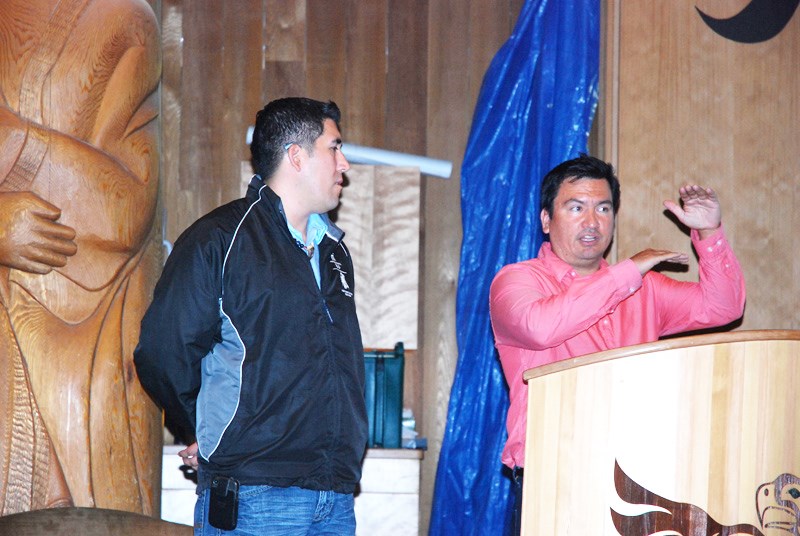The Squamish Nation is aware of the urgency, but has only started to assess the impact of major industrial proposals around Howe Sound, Chief Ian Campbell told participants in last week’s Community to Community Forum at the Sechelt longhouse.
“We’re not at a place yet to substantively do all our due diligence and research on things like LNG — we are just starting those processes,” Campbell said.
The forum was co-hosted by the shíshálh (Sechelt) Nation and the Sunshine Coast Regional District (SCRD), and one agenda item focused on major developments proposed for Howe Sound — the Burnco gravel mine at McNab Creek, the Woodfibre LNG plant, and the Metro Vancouver waste incinerator at Port Mellon.
“Those are issues that we’re talking about, but we’re not talking to each other,” Campbell acknowledged in response to a question from Gibsons Coun. Lee Ann Johnson. “That’s why I like to be here, because we start to remove the boogeyman from the bushes, if you will, saying we need to come together. The urgency is the first step. After urgency comes more collaboration and visioning and then building your coalitions and all these processes. We recognize there’s urgency.”
Campbell said the Squamish Nation has “just finally” developed a framework agreement on consultation, “to start identifying what we do see as appropriate consultation and engagement.”
The Band’s LNG framework agreement “was something that was met with resistance by the proponents as well as the environmental assessment and other regulatory bodies,” he said.
“And we basically just took the position that we’re not stakeholders in our own territories, we’re not going to be treated in an environmental assessment process that does not address Aboriginal rights and title and really has no mechanism to address those issues.”
On the Woodfibre LNG proposal, Campbell said his council has received feedback — “not only from our members, but from other First Nations and other British Columbians” — pointing out that the project cannot be looked at in isolation, as it involves climate change and the impact on fresh water from fracking in the North.
“These are concerns that we can’t continue to be in our own silo here and only look at the Howe Sound area or the Sunshine Coast, but what is the cause and effect of us allowing projects that may have harm elsewhere?”
“Our community is quite concerned about these issues, as well as your family,” Campbell told Islands Trust Gambier Island trustee Jan Hagedorn, who had questioned him on the LNG project. “I don’t have the answers as of yet, but we’re certainly pleased that we’re taking the next step in terms of creating a process.”
Campbell praised the work of the Howe Sound Community Forum — which brings together First Nations, local governments, and groups that have interests in Howe Sound — and credited it for helping the Squamish incorporate marine uses as it progresses to the second phase of its land-use plan.
He said he appreciated the patience of local governments such as the SCRD that have been waiting to sign protocol agreements with the Squamish.
“It’s been challenging for us to respond,” he said, “because of the magnitude of the issues within our territory,” which extends from Roberts Creek to the Lower Mainland, encompassing Howe Sound.
During the cultural component of the forum, Campbell shared traditional origin stories, as did Sechelt Nation historian Candace Campo, who was MC for the event. Speakers from both First Nations as well as the Sliammon Nation highlighted the strong family ties that existed between them through intermarriage.
“We never forget those connections and we’re always taught never to forget those connections,” Squamish Nation Coun. Christopher Lewis (Syeta’xtn) said.
Campbell, 41, was re-elected last December to the 16-member Squamish Nation council in an election that was widely seen as a changing of the guard for the Band. A hereditary chief, his ancestral name is Xalek and his chieftain name is Sekyu Siyam from the village of K’ik’elxn, at the site of Port Mellon in West Howe Sound.



